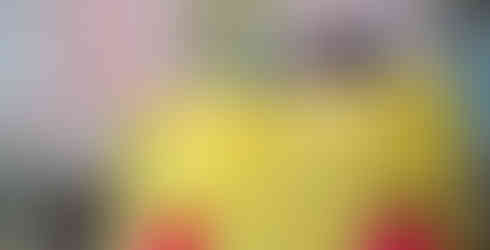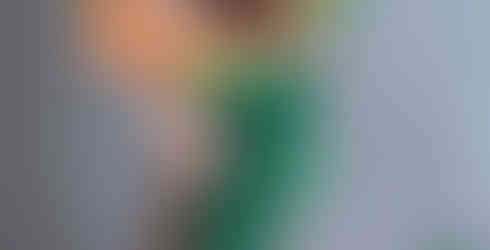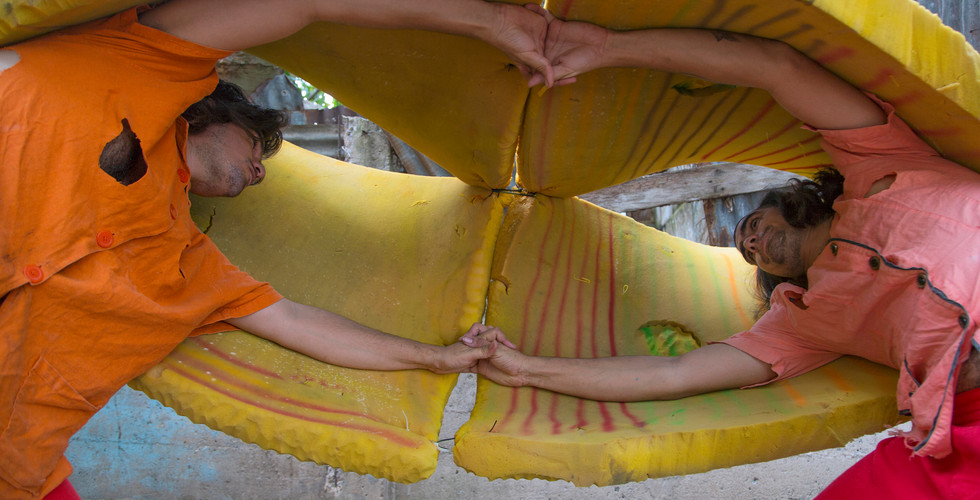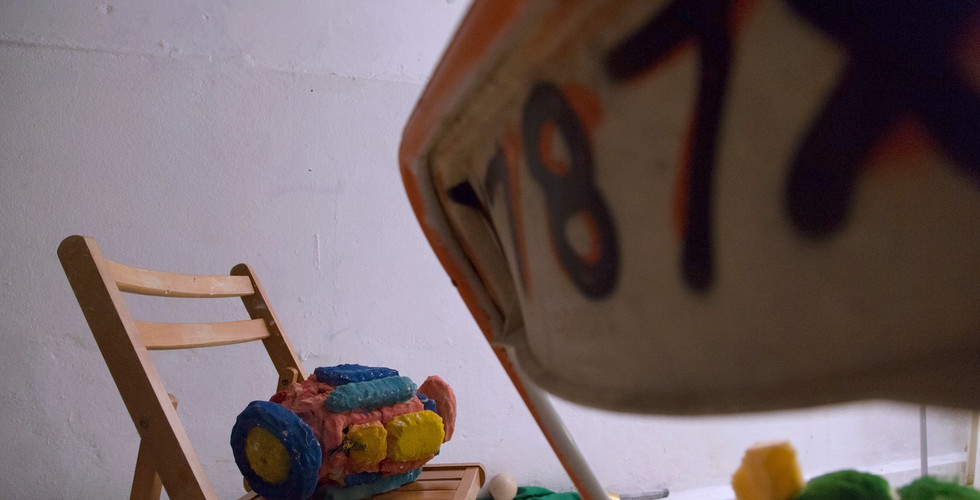Poncili Creación: Tranquilidad Caótica
- Edwin G. Domenech
- Apr 27, 2017
- 6 min read

Los hermanos Pablo y Efraín del Hierro trabajan, como ellos describen, en un estado de “tranquilidad caótica”. Sumergidos en ella, crean diferentes tipos de esculturas y títeres a los que les dan vida en sus performances.
¿Qué hace Poncili Creación?
Utilizamos el foam desnudo para crear esculturas manipulables que dirigimos en nuestros performances. En ellos, nos gusta incluir tanto al títere como al titiritero. Esto nos da una ventaja: el manipulador no se queda escondido, sino que también es un personaje dentro de la historia. No decimos que hacemos vestuario, ni títeres, ni coreografías, pero, si tenemos que ser o hacer una de estas cosas para completar la idea, lo hacemos. En fin, creamos nuestras ideas y tratamos de finalizarlas de cualquier manera.
¿Cómo comienza?
Al principio, como mezclábamos nuestras ideas con un grupo más grande de personas, nos llamábamos Colectivo Poncili. Además de liderarlo junto a nuestras novias, también invitábamos a la gente a traer ideas que trabajábamos entre todos. Siempre aparecía un poeta, alguien que también tenía un show, o personas que traían sus propios títeres, y todo se incluía en las presentaciones. Lo que queríamos era que la gente se expresara a través de Poncili. Este intercambio de ideas ocurría los miércoles en El Local.
¿De dónde nacen estas criaturas?
Hay distintos mundos. Hacemos cosas que son de estilo cartoon, otras que son más figurativas, y hay otra línea de la que salen objetos basados en lo arcaico o indígena. De esta última, salen los placebos como las cámaras y las pistolas. Son objetos que no son reales, pero han afectado la realidad como si lo fueran.
El material nos permite mucho; es bien suave, fácil de cortar, ligero, se dobla y desdobla de una manera particular, y se pega a sí mismo. Estas cualidades, de alguna manera, también hacen su aportación.
¿Qué papel juega el espectador en sus performances?
Al igual que no nos gusta esconder al titiritero, tampoco nos gusta esconder al público. En nuestras piezas, siempre haremos algo que lo involucre, aunque sea tirarnos sobre él.Cuando hay mucha gente, es difícil enganchar a cada persona e interactuar con ella. Así que, para solucionarlo, creamos emociones más allá. Por ejemplo, podemos tirar, con propósito dentro de la historia, uno de los títeres a alguna parte del público. Aunque le caiga a una sola persona, la incertidumbre de que le puede tocar a cualquiera crea tensión y energía en todos. También, nos gusta incitar el público a gritar, reír, y llorar con nosotros y los personajes. En ocasiones, la audiencia ha hecho y creado en el momento sus propias marionetas e historias con nosotros.
¿Qué colaboraciones han hecho y cómo creen que esto ha enriquecido su arte?
Siempre ha habido mucha colaboración. Hasta ahora, ha prevalecido la musical. Como nos interesa que los músicos reaccionen y fluyan con el show, nunca ensayamos con ellos. Incluso, tuvimos un tour en el que viajamos con dos instrumentos– un ukulele y una melódica– y se los dábamos a dos personas del público para que ellas hicieran la música.
De la colaboración, hemos aprendido a perderle la seriedad al asunto. No es ser mediocres en lo que hacemos, sino que no pensemos que nuestro arte es algo precioso que tenemos que cuidar. Si algo no sale como queremos, no nos vamos a echar a llorar. No hay peros, no hay por qué esperar que las cosas lleguen. Si necesitamos algo para que el show salga, lo hacemos y lo creamos nosotros mismos.
________
Como parte de varios proyectos que trabajará en Nueva York, el dúo Poncili Creación hará performances y talleres en Loisaida, Alphabet City (Manhattan). También, con el fin de darle un toque artístico y contemporáneo, participará en la Parada Puertorriqueña. Luego de eso, los hermanos esperan hacer una serie de tours: por la costa norte estadounidense, hasta llegar a Canadá; en Europa; y terminar el año en Chile y Argentina, donde los esperan muy buenos amigos.
Poncili Creación: Chaotic Tranquility
The brothers Pablo and Efraín del Hierro work, as they describe it, in a state of “chaotic tranquility”. Immersed in this condition, they create different types of sculptures and puppets, which are given life in their performances.
What does Poncili Creación (Poncili Creation) do?
We use bare foam to create easy-to-manipulate sculptures, which we direct in our performances. We like to include both the puppet and the puppet-master in our productions. This gives us an advantage: the puppet-master is not hidden; he is also a character within the story. We don’t say that we make costumes, puppets, or choreography; but, if we must be or make any of these things in order to complete an idea, we do. Finally, we create our ideas and try to finish them any way possible.
How did you start?
At the beginning, we called ourselves Poncili Collective because we mixed our ideas with those of a larger group of people. We also invited people to bring forward their ideas in order to develop them together, in addition to directing it along with our girlfriends. A poet always appeared, someone that had a show, or people that brought their own puppets along, and everything would be included in the presentations. We wanted people to expressed themselves through Poncili. This exchange of ideas took place Wednesdays at El Local.
From where are these creatures born?
There are different worlds. We do things that are cartoonish, others that are more figurative. There is also another line that produces archaic or indigenous-based objects from which placebos like the cameras and pistols originate. These are objects that are not real but have affected reality as if they were.
The material allows us to do much; it is very soft, easy to cut, it bends and unbends in a particular way, and it sticks to itself. In some way, these qualities also contribute to the performance.
What role do the spectators play in your performances?
The same way we do not like to hide the puppeteer, we do not like to hide the public either. We always do something that gets the viewers involved in our pieces, even if it’s just throwing ourselves at them. It is difficult to captivate and interact with a single person if there are many people. So, to fix this, we create boundless emotions. For example, we can —purposely, for the good of the story— throw a puppet at any part of the public. Even though it can land on one single person, the uncertainty that it can land on anyone builds tension and energy all-around. We also like to encourage the public to scream, laugh, and cry with us and the characters. Sometimes, the audience creates its own puppets and stories with us on the spot.
What collaborations have you done and how do you think they have enriched your art?
There has always been a lot of collaboration. So far, music has prevailed. We never rehearse with the musicians because we like them to react and flow with the show. We even had a tour in which we traveled with two instruments -a ukulele and a melodica - and gave them to two members of the public in order for them to create the music.
We have learned from the collaborations not to take these things too seriously. It doesn’t mean we are mediocre in what we do, but we do not think our art is something precious that we must take care of. We aren’t going to start crying if something doesn’t turn out how we wanted.There are no buts, there is no reason to wait for things to simply arrive. If we need something for the show to work out, we make and create it ourselves.
_________
As a part of various projects they will be working on in New York, the Poncili Creación duo will be performing and giving workshops in Loisaida, Alphabet City (Manhattan). In order to give it an artistic and contemporary touch, the duo will also be participating in the Puerto Rican parade. After this, the brothers hope to make a series of tours: through the north coast of the United States, until arriving at Canada; in Europe; and ending the year in Chile and Argentina, where good friends await them.
Autor | Author

Edwin G. Domenech
Actual estudiante de producción digital en la USC. Le gusta escribir historias y terminarlas, aunque esto último raramente pasa. Disfruta leer, comer pizza y mofongo y la buena compañía. Piensa que estaría chévere que cada cual sólo mandase en su casa. Les desea un lindo día.
Current digital production student at USC. He likes to write stories and finish them, although the finishing part rarely happens. Enjoys reading, eating pizza and mofongo and good company. He thinks it would be cool that everyone commands just at their home. Wishes you a nice day.

















































































































































Comments